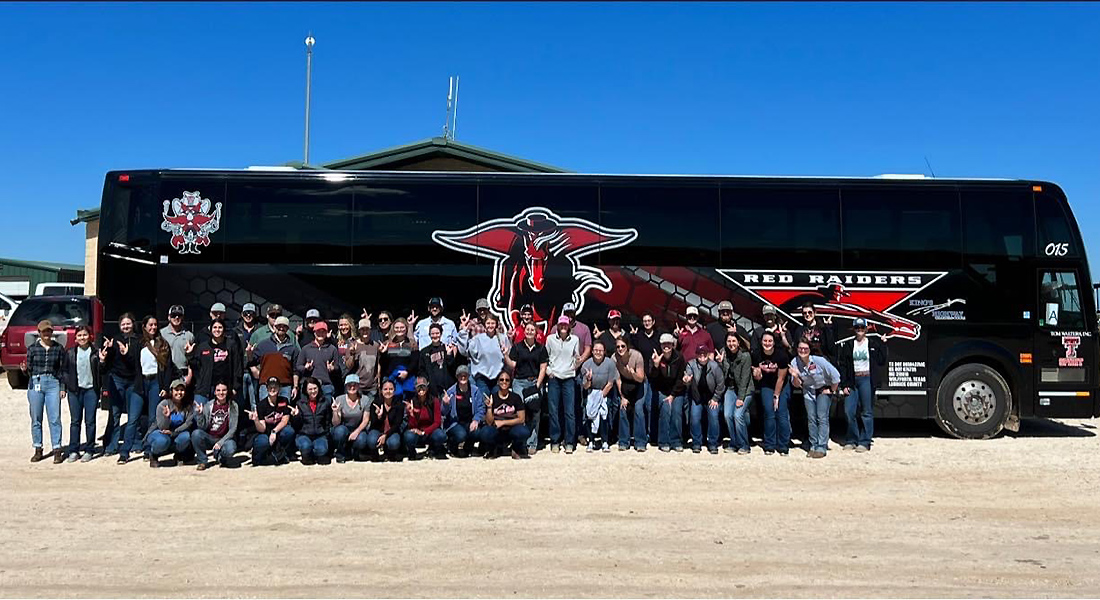
First-year School of Veterinary Medicine students engaged with local industry partners and explored their facilities.
Some people might wonder why a veterinary school was built in Amarillo. A big part of the answer is that Amarillo sits in the heart of U.S. agriculture and livestock production. It is a city and a region responsible for much of the Nation’s beef, dairy and pork production. It has – and still lives – rich heritage of ranching and horse raising.
During the second week of October, first-year students in Texas Tech University’s School of Veterinary Medicine journeyed to several local agriculture partners to see firsthand how they operate and relate to veterinary medicine.
Tuesday
First stop of the week, large commercial dairies southwest of town. The class of 2026 rode a bus together to learn about what owner David Lawrence, his son Michael Lawrence and son-in-law Cody Kirby have built together. David and his team were eager to show off their beautiful facilities and unique calf transition barn. During their special tour, students walked through all aspects of daily dairy operations. Students learned about veterinarians’ needs and their role in the dairy industry.
Wednesday
This day was set aside to explore two unique partners in Amarillo. To kick off the morning, students visited River Falls Equestrian Center, owned by Britney Caflisch and her family. Earlier in the semester, Britney visited the School of Veterinary Medicine to speak to the first-year class on the equestrian industry with a focus on the English world. Now, she hosted the first-year class at her facility to discuss every aspect of how her facility runs and how she trains and teaches experienced and novice equestrians. The part of her tour that gained the most attention was the state-of-the-art horse riding simulation model. This simulation model was imported from a European manufacture and very few are found in the U.S. She showed students how the model indicated the rider’s balance and the pressure they apply and and how these allow a rider and instructor to work together at a trot or canter and teach proper positions while jumping. This gives consistency in training and allows the rider to gain confidence before getting on a horse.
In the afternoon, students visited the Amarillo Animal Management and Welfare Administration. Director Victoria Medley discussed the history and logistics of the facility. She also elaborated on the skill set of the officers, the demands of the facility and the wonderful vets who care for the animals at the facility. After the presentation, students were given detailed tours by assistant director Kristopher Shaffer and outreach manager Kayla Sell. Students learned the layout and flow of a facility with a high volume of animals coming and going.
Thursday
Students wrapped up their week visiting two more partners. They started the day riding a bus to a facility northwest of Amarillo owned by Scott Ball and his sons Jerod and Justin. Scott and Jerod were thrilled to provide a detailed tour of their operation, allowing students to explore their facilities. During this tour, students took in the full scale of production and the amount of feed required to run their operation. They custom raise calves for dairies and have a state-of-the-art enclosed feed center, transition barns and weaning system. Students had the unique opportunity to visit with the owners as well as Kent Jisha, the operation’s veterinarian. They gained a better understanding of the dynamics and day-to-day demands of both veterinary medicine and the operation.
As the trip came to a conclusion, students made one last stop at a feedlot west of Amarillo. They were warmly welcomed by the owner Robert “Robbie” Kirkland and his manager. They provided a tour explaining the flow and care of the cattle on their custom feedlot. Students were able to see firsthand how animals were cared for using the highest standards. Also, the students were shown how the facility invested in cutting-edge technology to further enhance the care of animals.
Over the course of the three days, the RaiderVets gained a unique perspective of the broad impact that veterinary medicine has on animals. They will be able to take what they learned and apply it to their veterinary medicine careers and the communities these students choose to serve.
